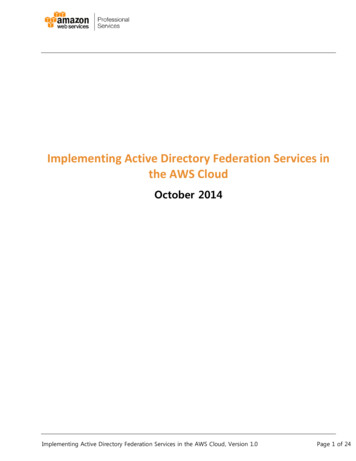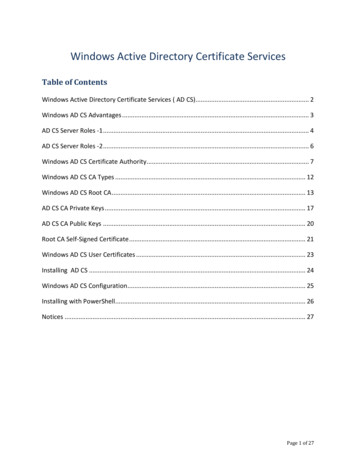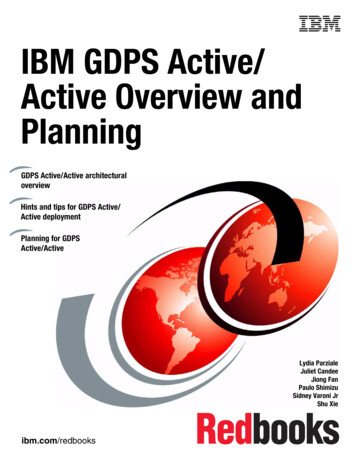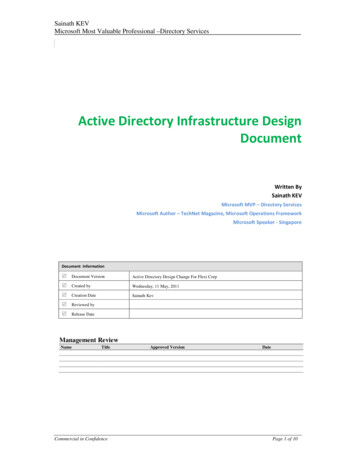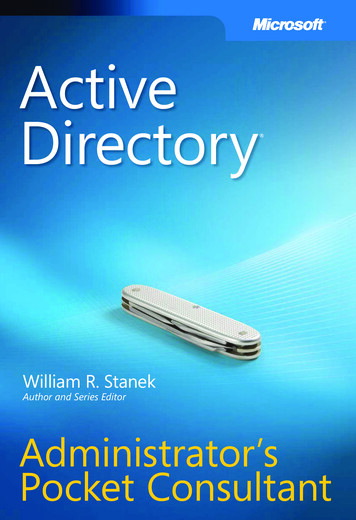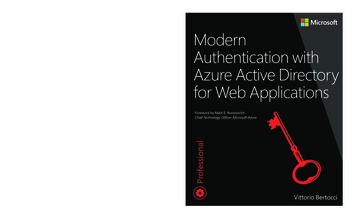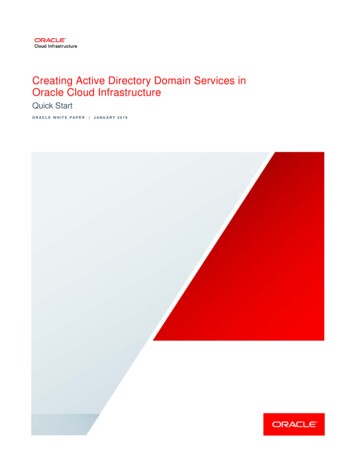
Transcription
Creating Active Directory Domain Services inOracle Cloud InfrastructureQuick StartORACLE WHITE PAPER JANUARY 2019
DisclaimerThe following is intended to outline our general product direction. It is intended for informationpurposes only and may not be incorporated into any contract. It is not a commitment to deliver anymaterial, code, or functionality, and should not be relied upon in making purchasing decisions. Thedevelopment, release, and timing of any features or functionality described for Oracle’s productsremains at the sole discretion of Oracle.Revision HistoryThe following revisions have been made to this white paper since its initial publication:DateRevisionJanuary 9, 2019Initial publicationYou can find the most recent versions of the Oracle Cloud Infrastructure white papers s.2 CREATING ACTIVE DIRECTORY DOMAIN SERVICES IN ORACLE CLOUD INFRASTRUCTURE
Table of ContentsOverview4Assumptions4Setting Up the Network Environment5Create a VCN6Create a NAT Gateway6Create a Private Security List6Create a Private Route Table6Create Security List Rules7Create Subnets8Creating a Bastion Host8Creating the Windows Instances8Configuring the Forest and Domain Controllers9Create the Primary Domain Controller10Add a Second Domain Controller16Add a New Host19Conclusion22References23Appendix A: ActiveDirectoryInit.ps123Appendix B: ActiveDirectoryInit2.ps125Appendix C: AddComputer.ps126Appendix D: NewComputer.ps1263 CREATING ACTIVE DIRECTORY DOMAIN SERVICES IN ORACLE CLOUD INFRASTRUCTURE
OverviewActive Directory Domain Services are a proven solution for identity management. Oracle CloudInfrastructure can help you build and extend your current Active Directory forest. This white paperwalks you through the process of creating an Active Directory environment in your Oracle CloudInfrastructure tenancy. Two domain controllers are installed, one active and one read-only, each ina different availability domain for redundancy. A third system is used as a test server to ensure thatyou can both join to and log in to the domain established in Oracle Cloud Infrastructure.This document provides the following information: How to automate the deployment of your Active Directory servers Best practices for building a simple Active Directory environment and joining domains Scripts that you can use to help automate your deployment in an Oracle CloudInfrastructure environmentThe following topics are out of scope and therefore not covered: Active Directory design and topologies Large forest, tree, and leaf designs Group policies or policy managementAssumptionsTo perform the actions in this paper, you must have a non-root compartment.Also, you should be familiar with the fundamentals of the Oracle Cloud Infrastructure. If this is thefirst time that you have used the platform, we recommend walking through the getting startedtutorial.You should also have a basic understanding of Active Directory concepts.4 CREATING ACTIVE DIRECTORY DOMAIN SERVICES IN ORACLE CLOUD INFRASTRUCTURE
Setting Up the Network EnvironmentThe following diagram depicts the components of the environment that this white paper includes:Best Practice: The domain controllers should not be accessible externally from the internet. Create aseparate subnet for your domain assets like Active Directory domain controllers and a separate subnet foryour application servers.A bastion host is used to access the environment to prevent exposing the Remote DesktopProtocol (RDP) ports of the Active Directory domain controllers to the internet. RDP sessions aretunneled through an SSH connection to a bastion host. Separate subnets (as illustrated in thediagram) are used to host the primary and secondary domain controllers created in the steps thatfollow. Because subnets are associated with availability domains, each of the domain controllersresides in different availability domains, thereby creating an Active Directory domain structure thatis resilient to availability domain issues. In the examples that follow, the virtual cloud network(VNC) IP space of 10.0.0.0/16 is used.Best Practice: Always be as descriptive as possible when naming Oracle Cloud Infrastructure components.Descriptive names make it easier when you have to revisit an environment later.5 CREATING ACTIVE DIRECTORY DOMAIN SERVICES IN ORACLE CLOUD INFRASTRUCTURE
Create a VCNUse the Oracle Cloud Infrastructure Console to create the virtual cloud network (VCN) and relatedresources, including the internet gateway for the bastion host, public routing tables, and securitylists for the public subnet. Two more public subnets are created but aren't used in thisenvironment. More networking resources for the private segments of the environment are createdin the following sections.Create the following VCN and related resources: vcn01Create a NAT GatewayCreate a NAT gateway to allow the instances that have only private IP addresses to accessinternet resources.Create the following NAT gateway: nat-gatewayCreate a Private Security ListWhen you create a subnet in the following steps, you must select a security list. Create an emptysecurity list now and add the rules in a later step.Create the following security list: Production - Active DirectoryCreate a Private Route TableCreate a route table to use for the private subnets. Private subnets automatically can route to otherprivate subnets in the VNC. The NAT gateway that you created is used by this route table for allinternet destinations, which allows instances that have only private IP addresses to access internetresource.Create the following route table with a 0.0.0.0/0 route to nat-gateway:NameTarget TypeDestination CIDR Block Target SelectionProduction - ActiveDirectory - NATNAT Gateway0.0.0.0/06 CREATING ACTIVE DIRECTORY DOMAIN SERVICES IN ORACLE CLOUD INFRASTRUCTUREnat-gateway
Create Security List RulesActive Directory uses several protocols to communicate, including RPC, NetBIOS, SMB, LDAP,Kerberos, WINS, and DNS. All of the protocols are listed here, although your configuration mightuse only some of them. If a protocol (for example, WINS) is not used in your environment, you canremove it from the list.As a best practice, all the domain controllers should be in a subnet that either has no external IPaddresses or has no access from the internet. As a result, you might want to enable all ports tocommunicate between your subnets and the Active Directory subnets. However, be aware that thisstill opens potential paths of attack from those subnets. Therefore, it's a best practice to open onlythe following ports between the subnets:NameProtocolPortRDPTCP3389DNSTCP, UDP53LDAPTCP, UDP389LDAP over SSLTCP636Global catalog LDAPTCP3268Global catalog LDAP over SSLTCP3269KerberosTCP, UDP88RPC endpoint mapperTCP, UDP135NetBIOS name serviceTCP, UDP137NetBIOS datagram serviceUDP138NetBIOS session serviceTCP139SMB over IP (Microsoft-DS)TCP, UDP445WINS resolutionTCP, UDP1512WINS replicationTCP, UDP42Create ingress rules on the Production - Active Directory security list to allow the required portcommunication into the new Active Directory subnets (these rules must exist to allow trafficbetween the two domain controller subnets).7 CREATING ACTIVE DIRECTORY DOMAIN SERVICES IN ORACLE CLOUD INFRASTRUCTURE
Create SubnetsAs mentioned previously, you need at least two private subnets (a third subnet in the thirdavailability domain can be used for extra availability of the Active Directory environment).Create the following subnets:AvailabilityNameDomainCIDR BlockRoute TableSecurity ListsProduction - Admin PHX-AD-1PHX-AD-110.0.10.0/24Production - ActiveDirectory - NATProduction - ActiveDirectoryProduction - Admin PHX-AD-2PHX-AD-210.0.20.0/24Production - ActiveDirectory - NATProduction - ActiveDirectory10.0.100.0/24Production - ActiveDirectory - NATProduction - ActiveDirectoryProduction - Application PHX-AD-2- PHX-AD-2Creating a Bastion HostA bastion host is used to access the Active Directory environment. This secures RDP sessions bytunneling them through an SSH tunnel. For more information about bastion hosts, see the BastionHosts: Protected Access for Virtual Cloud Networks white paper.Create a bastion host with the following details:NameImageShapeAvailability Domain SubnetBastionOracle Linux 7.5VM.Standard2.1PHX-AD-1Public Subnet PHXAD-1Creating the Windows InstancesThe example in this white paper uses three Windows Server 2016 instances. Two are used for theActive Directory domain controllers, and the third is joined to the domain as a new host. Use thefollowing properties when you create the instances in the following section. (The shape used in thispaper is a recommendation; scale it up or down as needed).8 CREATING ACTIVE DIRECTORY DOMAIN SERVICES IN ORACLE CLOUD INFRASTRUCTURE
NameImageShapeAvailabilitySubnetDomainWS16WAD3001 Windows Server2016 StandardVMVM.Standard2.1PHX-AD-1Production - Admin - PHXAD-1WS16WAD4001 Windows Server2016 StandardVMVM.Standard2.1PHX-AD-2Production - Admin - PHXAD-2WS16CN001VM.Standard2.1PHX-AD-2Production - Application PHX-AD-2Windows Server2016 StandardVMFor each instance, note the RFC1918 IP addresses:InstanceRFC1918 iguring the Forest and Domain ControllersYou can create your initial domain controller in several different ways. This paper uses MicrosoftPowerShell integrated with Cloudbase Init to reduce the amount of manual interaction with theActive Directory setup. The scripts provided in the appendices install the necessary WindowsServer features, such as the .NET Framework, Active Directory Domain Services, and the DNSserver components. Four PowerShell scripts are used to create this environment: Appendix A: ActiveDirectoryInit.ps1: Create the forest and promote the server to anActive Directory domain controller. Appendix B: ActiveDirectoryInit2.ps1: Build the second host and promote it to be thereplica domain controller. Appendix C: AddComputer.ps1: Prepare the domain for a new computer join. Appendix D: NewComputer.ps1: Join a Windows Server to the domain at launch time.This paper uses the Oracle Cloud Infrastructure Console to demonstrate how to create thecompute instances. You need the following information: Your domain administrator password. A best practice is to ensure that you change yourdomain administrator password immediately after you create the domain controllers.9 CREATING ACTIVE DIRECTORY DOMAIN SERVICES IN ORACLE CLOUD INFRASTRUCTURE
The name of the domain that you are about to create. A one-time password that you will use when joining new computers to the domain.Create the Primary Domain Controller1. In the Oracle Cloud Infrastructure Console, go to the Compute section and click CreateInstance.2. Provide a name for the instance (WS16WAD3001) and select the availability domain(PHX-AD-1).10 CREATING ACTIVE DIRECTORY DOMAIN SERVICES IN ORACLE CLOUD INFRASTRUCTURE
3. Choose the operating system (Windows Server 2016 Standard) and image version.4. Select the instance type (virtual machine) and the instance shape (VM.Standard2.1).Note: You can choose a larger boot volume size or encrypt the boot volume via the KeyManagement service. This white paper doesn't address this function.11 CREATING ACTIVE DIRECTORY DOMAIN SERVICES IN ORACLE CLOUD INFRASTRUCTURE
5. Configure your network connection.Best Practice: Ensure that your new domain controllers are in the private subnet.6. Under Advanced Options, select the Management view, and then choose thecompartment and fault domain.12 CREATING ACTIVE DIRECTORY DOMAIN SERVICES IN ORACLE CLOUD INFRASTRUCTURE
7. In the User Data section, select Paste cloud-init script and add the script to create thedomain controller. Copy the ActiveDirectoryInit.ps1 script from Appendix A and paste itin the text box:8. Click Create.The script takes approximately 20 minutes to complete the installation of the Windowsfeatures and the Active Directory tools.You can log in and monitor the progress by viewing the stage1.txt log atC:\DomainJoin. The log should show Success True for .NET Framework, ActiveDirectory Domain Services, Active Directory Administrative Center, and DNS ServerTools.13 CREATING ACTIVE DIRECTORY DOMAIN SERVICES IN ORACLE CLOUD INFRASTRUCTURE
9. After the first reboot, log in to the host with the domain\administrator account to executethe last script with the RunOnce script. The first login with the domain administratoraccount starts the RunOnce script and provides you a reference for when the entireprocess will be complete.After the RunOnce script completes, the instance restarts automatically as part of theprocess.14 CREATING ACTIVE DIRECTORY DOMAIN SERVICES IN ORACLE CLOUD INFRASTRUCTURE
10. Log back in and check the logs to ensure that there are no errors. The logs arestage1.txt and stage2.txt located in C:\DomainJoin.For success, stage2.txt should have Warnings but no Errors.15 CREATING ACTIVE DIRECTORY DOMAIN SERVICES IN ORACLE CLOUD INFRASTRUCTURE
11. Verify that the domain has been successfully created by opening the Start menu andselecting Windows Administrative Tools Active Directory Users and Computers.Now you have the first domain controller in the new Active Directory forest. The new forest is readyfor configuration that is not covered in this paper, such as group policies, more domain trusts, andDNS configurations.Add a Second Domain ControllerRepeat steps 1–6 in the previous section to create a backup domain controller. Make theappropriate changes in the name of the instance and in setting the appropriate availability domainand the correct fault domain to ensure that you have proper redundancy for your domain. The nextseries of steps use the script from Appendix B.Best Practice: To ensure best availability, we recommend that you deploy across multiple availabilitydomains, or fault domain within one availability domain.1. Under Advanced
Active Directory Domain Services are a proven solution for identity management. Oracle Cloud Infrastructure can help you build and extend your current Active Directory forest. This white paper walks you through the process of creating an Active Directory environment in your Oracle Cloud Infrastructure tenancy. Two domain controllers are installed, one active and one read-only, each in a .
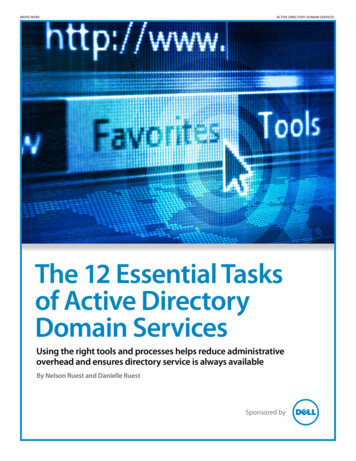
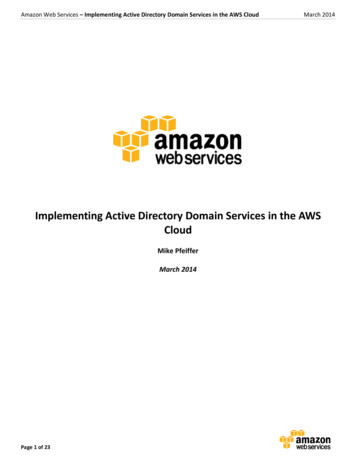
![[MS-ADFSOD]: Active Directory Federation Services (AD FS .](/img/1/5bms-adfsod-5d.jpg)
